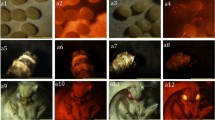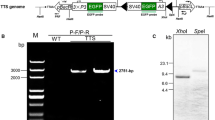Abstract
Vector DNA (pBmFRT) microinjected into the silkworm eggs (preblastoderm stage) persisted in different conformational forms throughout the period of embryonic development. Southern blot analysis confirmed the persistence of DNA as extrachromosomal copies. Slot blot analysis showed the inheritance of the injected DNA to the subsequent progenies; however the copy number of the injected vector declined in the progenies.
Similar content being viewed by others
References
Adams DS, Eickbush TH, Herrera RJ, Lizardi PM (1986) A high reiterated family of transcribed oligo (A)-terminated interspersed DNA elements on the genome of Bombyx mori. J Mol. Biol. 187: 465-478.
Crampton JM, Eggleston P (1994) Transgenic insects In: Maclean N, ed. Animals with Novel Genes. USA: Cambridge University Press, pp. 21-62.
Etkin LD, Pearman B, Roberts M, Bektesh SL (1984) Replication integration and expression of exogenous DNA injected into fertilized eggs of Xenopus laevis. Differentiation 26: 194-202.
Golic MM, Rong YS, Pertersen RB, Lindquist SL, Golic KG (1997) FLP-mediated DNA mobilization to specific target sites in Drosophila chromosomes. Nucl. Acids Res. 25: 3665-3671.
Jeyaprakash A, Lopez G, Hoy MA (1998) Extrachromosomal plasmid DNA transmission and amplification in Metaseiulus occidentalis (Acari: Phytoseiidae) transformants generated by maternal microinjection. Ann. Entomol. Soc. Am. 91: 730-736.
Marshall A (1998) Insects are coming. Nature Biotechnol. 16: 530-532.
Mathi SK, Walker VK, Wyatt GR (1991) Expression from two Drosophila promoters in embryos of migratory Locust. Insect Biochem. 21: 623-629.
Morris AC, Schaub TL, James AA (1991) FLP-mediated recombination in the vector mosquito, Aedes aegypti. Nucl. Acids Res. 19: 5895-5900.
Nagaraju J, Kanda T, Yukuhiro K, Chavancy G, Tamura T, Couble P (1996) Attempt at transgenesis of the silkworm (Bombyx mori L.) by egg injection of foreign DNA. Appl. Entomol. Zool. 31: 587-596.
Nikolaev AI, Tchkonia TT, Kafiani-Eristavi CA, Tarantul VZ (1993) Preferential extrachromosomal localization of exogenous DNA in transgenic silkworm Bombyx mori L. Mol. Gen. Genet. 236: 326-330.
O'Brochta DA, Atkinson PW (1996) Transposable elements and gene transformation in non-Drosophilid insects. Insect Biochem. Molec. Biol. 26: 739-753.
Rubin GM, Spradling, AC (1982). Genetic transformation of Drosophila with transposable element vectors. Science 218: 348-353.
Sambrook F, Fritsh EF, Maniatis T (1989). Molecular Cloning: A Laboratory Manual. Cold Spring Harbor, N.Y.: Cold Spring Harbor Laboratory Press.
Shamila Y, Mathavan S (1996) A simple revised manual microinjection method of gene transfer into Bombyx mori eggs. Indian. J. Seric. 35: 80-82.
Shen NLL, Sofer WH (1991) Introduction of single-stranded ADH genes into Drosophila results in tissue-specific expression. Biochem. Biophys. Res. Commun. 174: 1300-1305.
Steller H, Pirrotta V (1985) Fate of DNA injected into early Drosophila embryos. Dev. Biol. 109: 54-62.
Author information
Authors and Affiliations
Rights and permissions
About this article
Cite this article
Shamila, Y., Mathavan, S. Extrachromosomal transmission of microinjected DNA to the progeny of silkworm Bombyx mori. Biotechnology Letters 21, 425–430 (1999). https://doi.org/10.1023/A:1005537027739
Issue Date:
DOI: https://doi.org/10.1023/A:1005537027739




